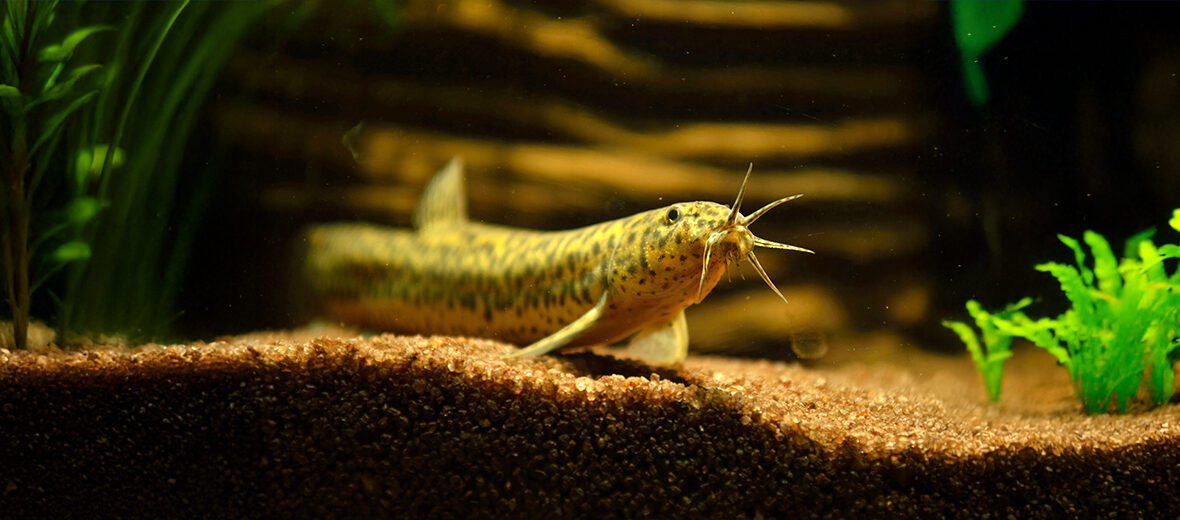
The pond loach, aka oriental weatherloach, oriental weatherfish, or dojo loach, originally hails from east Asia, but has been introduced to other parts of Asia, as well as to Europe, North America, and Australia. They face the threats of ecosystem modifications and water pollution. However, due to their abundant, global populations, these fishes are listed as Least Concern by the IUCN. Their population status is listed as unknown.
First the Stats…
Scientific name: Misgurnus anguillicaudatus
Weight: Up to .31 lb.
Length: Up to 12 inches
Lifespan: Up to 15 years
Now on to the Facts!
1.) These omnivores (feed on plant and animal matter) are bottom feeders that feast on algae, organic matter, tubifex worms, blood worms, daphnia, snails, and other aquatic invertebrates.
2.) They are capable of surviving short droughts by covering themselves with a layer of mucus which aids in preventing desiccation (drying out).
3.) While able to survive in poor quality water, in aquariums, they are best kept in clean conditions to prevent disease and to promote a longer lifespan.
4.) These fish have the unique ability to burrow into soft or muddy substrates and breathe atmospheric air through enteral respiration (cloacal or intestinal respiration, aka they can breathe through their butt).
5.) When on land, pond loaches can suppress protein breakdowns and catabolism (which avoids the creation of ammonia), switch to partial amino catabolism (which creates non-toxic alanine rather than ammonia), convert ammonia to non-toxic glutamine, and remove ammonia by excreting it as NH3 gas.
But wait, there’s more on the pond loach!
6.) High levels of ammonia doesn’t seem to have much of an effect on these fish either, yet it is not known how these critters can survive levels of ammonia that would kill most other fish.
7.) Pond loaches can reproduce sexually and asexually. When producing asexually, the eggs hatch and develop into identical clones (without any genetic contribution from a male’s sperm) by the process of gynogenesis (a form of parthenogenesis, this is a system of asexual reproduction that requires the presence of sperm without the actual contribution of its DNA for completion).
Did you know…?
These loaches get their common name of weatherloach or weatherfish due to their ability to detect changes in barometric pressure before a storm and react with frantic swimming and/or standing on end, aka pencilling.
8.) While being primarily nocturnal (active at night), these loaches can also be cathemeral (active both day and night).
9.) In aquariums, when housed together with other individuals, which is typically recommended, pond loaches will often “cuddle” and rest huddled-together.
10.) These fish are peaceful and get along well with all other fish.
But wait, there’s still more on the pond loach!
11.) A popular food fish in eastern Asia, they are raised in large scale fish farming. According to FAO, weatherloaches were 30th on the list of most important species in aquaculture, in terms of total weight produced in 2018.
12.) In Korea, loach soup, aka chueo-tang, is made with pond loaches. The Japanese hotpot dojō nabe, a specialty of Asakusa, is also made with these fish.
13.) Between 2010 – 2020 dojo loaches were found in 10 states in the United States including Alabama and Georgia. The Georgia find was in November 2020 in McNutt Creek in Athens, on the border of Clarke and Oconee.
14.) Even though they are generally peaceful, these loaches are considered an invasive species as they grow fast and large, and can out compete other native fish for food resources.
Now a Short Pond Loach Video!
Be sure to share & comment below! Also, check out the Critter Science YouTube channel. Videos added regularly!

Want to suggest a critter for me to write about? Let me know here.
Some source material acquired from: Wikipedia & IUCN
Photo credit: Manoel Jr.



